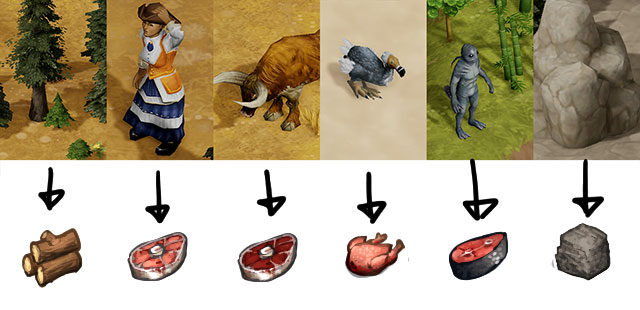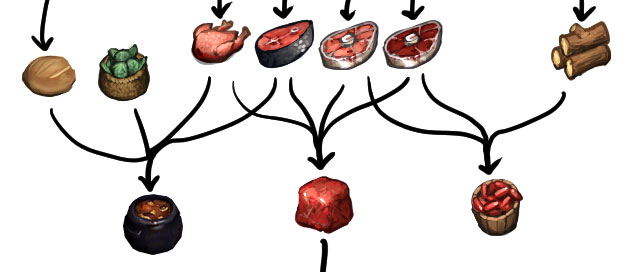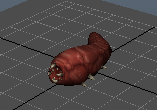Here at Gaslamp Games we each have our “particular enthusiasm” and as previously established, mine is the industrial logistics simulation. Let’s talk a bit more about how that works.
Most everything on the game map can have resources harvested from it in one way or another (and we really mean another). Trees, rocks, crops, animals, people, Other Things. You combine these to make other things. The natural environment of your settlement determines what resources are abundant and what resources are not. If you settle on the Black Dunes of Whispering, expect anything to do with resources tagged “timber” to be a lot more relatively expensive. But look on the bright side, I’m sure there are advantages to living on the Black Dunes of Whispering. For example, lots of whispering. And bones.
It’s simply, really.
Here’s a rock:
Let’s break this down piece by piece:
- The “name” is as straightforward as something spelled like “rhyolite” can ever be (I still mess it up).
- “type” is what kind of scripted gameobject we are; an “oreNode” is an object on the map that can be mined piecemeal until exhausted. (Underground mines are a separate matter.)
- The “devolves” flag means that the oreNode has a visual size that degrades as it is mined out.
- “commodityOutput” is the resource — a “commodity” in game terms — we get from mining the oreNode.
- “numOutput” is around how many units of commodity you get to mine out per size of oreNode. This may be given randomness.
- “tool” is, er, the tool we use to harvest from this oreNode (and the tool may itself count as a commodity, so you could theoretically mine pickaxes from the pickaxe oreNode, but we’re still knife-fighting about the particulars of how tools work. Likewise I’m knife-fighting with the code about how tool animations work with jobs and it’s pretty much a spiral of madness.)
- “models” are the 3d models displayed per size, and if there are multiple models in the list, a random variation is chosen. You may now choose from “blocky” or “lumpy”.
I daresay this is all subject to change and, happily, it just takes a touch of Lua scripting to make any change. Just the other day I made trees explode when chopped down. Want to mine meat from rocks? Easy!
So we mine all this meat from the meat outcropping using a butcher’s cleaver as a tool — what do we do with it?
Well, as with so much in Clockwork Empires, pretty much whatever.
Because I like the Refinery — combination ore-processing and charcoal manufacturing workshop — we’re going to look at one of the definitions for the output of a Refinery. (Another likable aspect of the Refinery which may interest you is the fact that you may attach the Crucible to it.)
Here’s part of the definition for a Refinery’s products, not including visuals, module composition, or what these transformations actually entail. Because it’d be silly to put all of that in one file so I didn’t have to have four frickin’ tabs open, one on one half of each screen across two monitors, to sort out what in the name of Quag’garoth is going on when my bloody work crew won’t make bloody stone bricks out of the rhyolite I painstakingly mined from a devolving oreNode. That’d be too easy. It must be hard. Difficulty is pain and Art is Pain. It also has nothing to do with the Aurochs.
“Smelt Iron Ore” is repeated because one is a display name, the other is an internal job name. For translation. We could, say, create Cooked Fleshcubes from Raw Fleshcubes mined from the Fleshmine in the Meatlands biome.
Now stick that in a tin (see: Kitchen workshop definition) to create Crates of Tinned Meat and you’re in business!
Just make sure the Deathwurm doesn’t get wind of your vast stockpiles of meat because they’ll come over and begin to feed. Call out the militia, slay the Deathwurms, harvest their corpses, and you’ve got more meat!
It’s beautiful how these systems work together to reinforce one another, isn’t it?






Evil begets evil, meat begets meat!
This update in a nutshell: http://pbfcomics.com/153/
I hope there will be lead, for, you know, bullets and lead poisoning. And mercury for the mad hatters.
Also: Here’s hoping that no matter how thin the prospect of defeating an ancient abomination, your brave townsfolk will be rewarded with a shower of rare eldritch meats.
Or if they don’t defeat it they will be showered in townsfolk meat….
In Clockwork Empires, meat eats YOU.
I note the sprouts are self-created — a sure sign of divinity. All hail the Holy Sprouts of Purity, that they may cleanse the Fishy Taint. All hail the sprouts. HAIL THEM.
But where is the cheese excavated?!
I wonder why not all the meat can go into the stew.
(Because it’d make the chart messy. Anything tagged “raw_meat” can go into stew. Tags are another thing that’s neat, but that’s for another blog post.)
Excellent!
I am curious. What´s whith the “Good names” and bad names” in the definition of the refinery?
Some workshops are run by industrious, loyal, upstanding subjects of The Queen. Some workshops are run by cultic, foreign, labour-organizing, gin-soaked ne’er-do-wells. The idea is that the name given to a workshop may reflect the character of the, er, character running it.
“…ticket to the sausage factory…”
…Fishy Taint….”
So many phrases that belong in The Book of Offending Pick-Up Lines
The short story this title is referencing is one of my favourites:
http://www.terrybisson.com/page6/page6.html
Yes!
Will it be possible for an entire Cheese themed area to settle in? With cheese trees, that when chopped down produce cheese wood and cheese leaves; that can be used to make a cheese bed?
So Cheesy
Modding this in would be remarkably easy.
I always thought Clockwork Empires should be more like Worms: Armageddon.
I too am a fan of meat and meat by-products, sir.